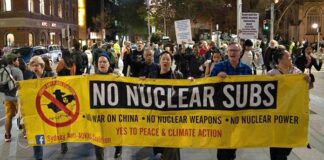On the eve of ANZAC Day, Anthony Albanese joined Defence Minister Richard Marles and Defence Industry Minister Pat Conroy to launch the public version of the Defence Strategic Review, which further entrenches the push to war with China.
The Review confirms the AUKUS pact and its nuclear submarines were neither a directive from Washington, nor a Scott Morrison thought bubble, but the mainstream thinking of Australia’s government and military elite.
Our leaders understand that their ally, the US government, risks losing its undisputed control of “Indo-Pacific” waters as China builds its navy on the back of its superior economic growth.
This also threatens Australia’s dominance of its neighbours to the north and east, under the umbrella of American power.
Impactful projection
The Review overturns the previous “Defence of Australia” doctrine in favour of “National Defence”, with greater capacity for “impactful projection across the full spectrum of proportionate response”.
In plain English, this means more ability to wreak havoc well beyond Australia’s shores. The Review acknowledges that invasion of the Australian continent is only a “remote possibility” but talks up other threats. The phrase “not fit for purpose” recurs when talking about the current state of the Australian Defence Force (ADF).
The Review lists multiple “threats” to Australia including attacks on trade routes, cyber warfare and the use of long-range missiles. The conclusion is that Australia must develop its capabilities in all these areas, strengthen its “littoral” (coastline) abilities with new coastal landing craft, and strengthen bases in northern Australia to project power beyond its borders.
Marles has been talking up the danger of Chinese threats to shipping in particular, using this to argue for the $368-plus billion nuclear submarines. As the satirical show Utopia and others have pointed out, much of Australia’s trade through the contested South China Sea is with China itself.
In any case a handful of nuclear submarines can’t protect every cargo ship, and there are alternative routes to other trading partners. What’s really at stake is the ability of the US to control both civilian trade and military shipping, enforcing the “rules based international order” it’s created to advantage its own companies (and those of favoured allies).
The media is adding to the scaremongering, with The Age reporting that the classified version of the Review war-games a scenario where a Chinese military base is built in a neighbouring island nation. Its source is quoted as saying that Australia would lose—“The message was, ‘You’re f—ed’.” Never mind the idea that “we” respect the sovereignty of nearby nations.
Apart from war provoked by our rulers, we do face one genuine existential threat—climate change. The Greens’ Adam Bandt correctly observed the Review “only gave a nod to climate, and mainly through the narrow lens of disaster response”. The concern is that rescuing people from disasters will distract the military from its real purpose of fighting foreigners.
The military is a huge contributor to CO2 emissions. In its discussion of building up military bases in the north of Australia, the Review identifies “clear opportunities in leveraging the capabilities offered by civil minerals and petroleum resources infrastructure, including those being considered for decommission”. Like many of the new initiatives, the upgraded bases will add to demand for carbon-spewing fossil fuel projects into the future.
Whole-of-nation
The Review points to a future where the military is much more prominent throughout Australian society, under the banner of a “whole-of-nation approach”. A preoccupation is the recruitment of tens of thousands more people, in and out of uniform, to sustain the war machine.
We can expect more efforts like that of South Australia’s Malinauskas government to promote military-oriented skills and courses in education, from schools to universities.
This hijacking of education to promote warfare means student and staff unionists have a key role to play in fighting the militarist agenda.
The University of Adelaide hosted a visit by NATO Heads of Mission last week as part of this push to militarisation. As well as boosting the anti-China campaign, NATO is playing with nuclear fire by fuelling the current bloodbath in Ukraine. Staff and students backed a lively, angry protest to greet the visitors.
Blank cheque
The least surprising conclusion of the Review is that “defence funding should be increased”. It found that more than $42 billion in additional defence spending had already been announced from 2020 to mid-2022, without funding being organised.
While reassigning some existing spending, Defence Minister Marles effectively offered a blank cheque for the future: “What you know is, it’s going to be more—but how much more is impossible to say at this point.”
Despite the conviction that more spending is needed, there is a contradiction between the scale of rearmament advocated by the Review and Albanese’s claim defence won’t absorb more funding over the next four years.
The government has been at pains to stress the reorientation of defence is consistent with its calls for budget restraint on social services. But it’s clear that military spending is going to keep on climbing.
The army will face cutbacks in land fighting resources, compensated by gaining control of new long-range missiles.
The looming cuts to the army have produced some dissent among war hawks. We can celebrate our enemies falling out with each other but should guard against thinking any of them can be useful allies.
Unsurprisingly the Opposition has swooped on the call for greater spending on the military. They’re highlighting the Review’s call for urgency, implying a need to spend more immediately.
The Saturday Paper quoted ANU professor, and former army colonel, John Blaxland saying the government is “afraid” to increase spending now “because they’re about to hand down a budget that is not very generous on health, welfare and education. You need to have a conversation with the electorate that 2 per cent [of GDP] is not enough. And we need to suck it up.”
True enough, this week’s Budget takes defence spending over 2 per cent of GDP for the first time. It puts annual spending at $57.6 billion within four years and more than 2.3 per cent of GDP in a decade.
The challenge for the peace movement is to continue building alliances with unions and campaigns for social spending so we can keep Albanese and Marles—and their successors—afraid to follow through further with their plans for war.
By Robert Stainsby
See the Australian Anti-AUKUS Coalition website for details of coming actions, including demos against the Quad military pact.






